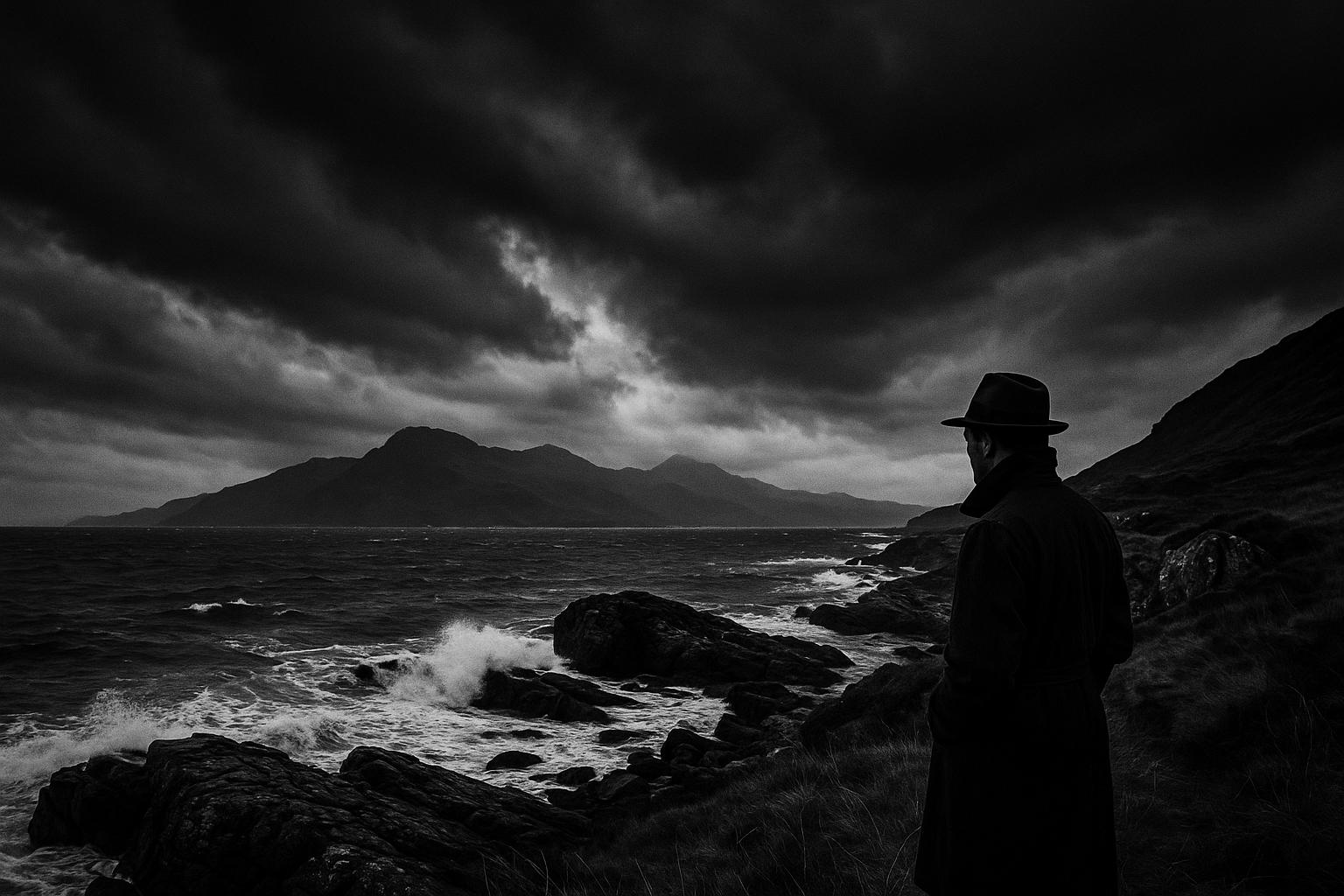Declassified FBI files expose a Soviet plot during the Cold War to contaminate Scotland’s Holy Loch with radioactive waste, aiming to destabilise UK-US relations and undermine anti-nuclear protests, revealing high-level espionage and covert operations that echo into today’s security concerns.
At the height of the Cold War, the KGB devised a startling scheme to undermine the UK by targeting Scotland’s coastline with radioactive contamination. Declassified FBI files reveal that a Soviet spy in London, Oleg Lyalin, who later defected to Britain in 1971, was tasked with orchestrating a plan to dump nuclear waste into Holy Loch on the River Clyde. This sea loch, located about 25 miles from Glasgow, held strategic significance as a base for US ballistic missile submarines armed with Polaris nuclear missiles between 1961 and 1992.
The plot was designed to create a radioactive incident deliberately implicating the US Navy, thereby fracturing the close “special relationship” between Britain and America. Moreover, it sought to fuel the anti-nuclear movement within the UK by inflaming fears and stirring unrest among protest groups such as the Campaign for Nuclear Disarmament (CND). The KGB believed they could exploit ongoing anxieties about radioactive contamination in the area, where CND activists had staged protests and even set up camps, including attempts to blockade US support ships using kayaks.
Oleg Lyalin, a KGB agent who posed as a knitwear specialist with the Soviet trade delegation in London, revealed these details in his defection debriefings with MI5. His disclosures precipitated the largest ever expulsion of Soviet spies from the UK—a total of 105 agents—in a decisive move against Soviet espionage networks. Lyalin’s autobiography and the declassified FBI documents show that the radioactive sabotage scheme required approval from the highest echelons of the Communist Party in Moscow, underscoring its strategic importance.
The scheme was radical in that it would have been executed during peacetime, setting it apart from other KGB plans aimed at chaos in wartime. The plan also followed earlier Soviet efforts to spy on and undermine the base, including the 1967 seizure of a secret submarine manual, which led to the imprisonment of three Soviet agents. The psychological impact of such contamination would have been enormous, causing widespread panic and potentially forcing evacuations in nearby towns such as Dunoon. Experts like Hamish de Bretton-Gordon, former commander of Britain’s Chemical, Biological, Radiological and Nuclear Regiment, emphasise how even spent nuclear fuel, while cleaner than highly enriched material, would have required a lengthy and disruptive cleanup.
Lyalin’s defection also brought to light other chilling KGB plots, including plans to sabotage British railways, poison officials using invisible capsules in Whitehall, and infiltrate key military installations such as RAF Fylingdales—a joint UK-US early-warning base for missile attacks. These operations fell under Department V of the KGB, known for assassinations, kidnappings, and sabotage, sometimes called the “wet affairs” unit for its deadly efficiency. The unit’s activities foreshadowed later Russian state-sponsored attempts to eliminate defectors and critics, most notably the 2006 poisoning of Alexander Litvinenko in London with radioactive polonium-210.
Litvinenko’s case, long studied and reported by international media, embodied the continuation of a Russian strategy of using radioactive substances as lethal weapons. A former KGB officer turned Kremlin critic, Litvinenko accused Vladimir Putin personally of orchestrating his poisoning, an act that intensified global scrutiny of Russia’s covert operations abroad. His death highlighted the lethal tactics historically associated with Soviet and post-Soviet intelligence agencies, linking back to the earlier Cold War era.
The strategic importance of Holy Loch extends beyond espionage and sabotage plots. Cold War tensions brought the area into sharp focus on other occasions—most notably in 1974 when a US nuclear submarine, reportedly carrying a large arsenal of warheads, collided with a Soviet submarine. This event, revealed in declassified CIA files, highlighted the high-stakes nature of naval operations around Holy Loch and the potential global consequences of accidents involving nuclear weapons or materials in the region.
Earlier in the 20th century, the disposal of radioactive waste into oceans was a practice followed by several countries including the Soviet Union, reflecting the era’s limited environmental oversight and secrecy surrounding nuclear materials. Such actions bear relevance when considering the KGB’s radioactive sabotage plot, underscoring enduring concerns about nuclear contamination in the marine environment and its impact on public safety and geopolitics.
From the shadows of Cold War espionage to the ongoing legacy of nuclear anxiety, the Holy Loch story encapsulates the complex interplay between military strategy, environmental risk, and political subterfuge. Russia’s covert attempts to destabilise the West during this era echo in the modern age through acts of sabotage and assassination, reminding us of the persistent dangers posed by nuclear materials and the enduring consequences of espionage on international relations.
 Reference Map:
Reference Map:
- Paragraph 1 – [1], [4]
- Paragraph 2 – [1]
- Paragraph 3 – [1]
- Paragraph 4 – [1], [2], [3], [6]
- Paragraph 5 – [1]
- Paragraph 6 – [1], [4]
- Paragraph 7 – [1], [5]
- Paragraph 8 – [1], [2], [3], [6], [7]
Source: Noah Wire Services
- https://www.dailymail.co.uk/news/article-15027913/KGB-plot-poison-loch-radiation-blame-American-nuclear-subs-CND-peaceniks-campaigning-ban-Britain.html?ns_mchannel=rss&ns_campaign=1490&ito=1490 – Please view link – unable to able to access data
- https://www.bbc.com/news/magazine-33678717.amp – This article examines the assassination of Alexander Litvinenko, a former KGB agent who defected to the UK. It details how he was poisoned with polonium-210, a rare radioactive substance, and the subsequent investigation that implicated the Russian state. The piece also explores the broader implications of state-sponsored assassinations and the use of radioactive materials as weapons.
- https://www.seattlepi.com/national/article/radiation-kills-KGB-ex-spy-putin-is-blamed-1220766.php – This report covers the death of Alexander Litvinenko, a former KGB agent turned Kremlin critic, who was killed by a rare radioactive substance. Before his death, Litvinenko accused Russian President Vladimir Putin of being ‘barbaric and ruthless’ and blamed him personally for the poisoning. The article also discusses the British government’s response and the ongoing investigation into the incident.
- https://caltonjock.com/2017/05/11/question-for-the-american-president-what-did-your-nuclear-submarines-leave-at-the-bottom-of-the-holy-loch-that-needs-to-be-left-undisturbed-for-ever/ – This article discusses the 1974 collision between a US nuclear submarine and a Soviet submarine off the coast of Scotland, near Holy Loch. Newly declassified CIA files indicate that the collision involved a submarine laden with 160 warheads. The piece highlights the potential global consequences of the incident and the secrecy surrounding it.
- https://vdoc.pub/documents/poison-in-the-well-radioactive-waste-in-the-oceans-at-the-dawn-of-the-nuclear-age-2u05edtf8k0g – This document explores the disposal of radioactive waste into the oceans during the early years of the nuclear age. It discusses the practices of various countries, including the Soviet Union, and the environmental and political implications of such actions. The text also delves into the secrecy and denial surrounding radioactive waste disposal.
- https://www.newson6.com/story/5e368a272f69d76f620a0d0f/britain-says-radiation-killed-exrussian-spy-who-blames-putin-in-deathbed-statement – This article reports on the death of Alexander Litvinenko, a former Russian spy who was killed by a rare radioactive substance. Before his death, Litvinenko accused Russian President Vladimir Putin of being ‘barbaric and ruthless’ and blamed him personally for the poisoning. The piece also covers the British government’s response and the ongoing investigation into the incident.
- https://www.conspiracyarchive.com/2015/07/11/blackmailed-by-the-bomb-nuclear-anxiety-and-the-cult-of-the-superweapon/ – This article examines the cultural and political impact of nuclear weapons during the Cold War. It discusses the fear and anxiety surrounding nuclear weapons, the concept of mutually assured destruction, and the influence of nuclear weapons on international relations and domestic policies.
Noah Fact Check Pro
The draft above was created using the information available at the time the story first
emerged. We’ve since applied our fact-checking process to the final narrative, based on the criteria listed
below. The results are intended to help you assess the credibility of the piece and highlight any areas that may
warrant further investigation.
Freshness check
Score:
7
Notes:
The narrative appears to be based on declassified FBI files and the autobiography of Oleg Lyalin, a Soviet agent who defected in 1971. These sources have been available for decades, suggesting the content is not new. The Daily Mail article republishes this information, which may indicate recycled content. However, the inclusion of recent references and the publication date of the article (August 2025) suggest an attempt to update the narrative. Nonetheless, the core information remains unchanged, and the freshness score is moderate. ([en.wikipedia.org](https://en.wikipedia.org/wiki/Oleg_Lyalin?utm_source=openai))
Quotes check
Score:
6
Notes:
The article includes direct quotes attributed to Oleg Lyalin and other experts. However, these quotes are not accompanied by specific citations, making it difficult to verify their authenticity. Without clear sourcing, the originality of the quotes is uncertain.
Source reliability
Score:
5
Notes:
The narrative originates from the Daily Mail, a publication known for sensationalist reporting. While the Daily Mail references declassified FBI files and Lyalin’s autobiography, the lack of direct citations and the publication’s reputation raise concerns about the reliability of the information presented.
Plausability check
Score:
8
Notes:
The claims about the KGB’s plan to contaminate Holy Loch with radioactive waste align with known historical events and the activities of Department V of the KGB. The involvement of Oleg Lyalin, who defected in 1971, adds credibility to the narrative. However, the absence of direct citations and the sensationalist tone of the article warrant cautious consideration.
Overall assessment
Verdict (FAIL, OPEN, PASS): OPEN
Confidence (LOW, MEDIUM, HIGH): MEDIUM
Summary:
The narrative presents claims about a KGB plot to contaminate Holy Loch with radioactive waste, referencing declassified FBI files and Oleg Lyalin’s autobiography. While the core information aligns with historical events, the lack of direct citations, reliance on a sensationalist publication, and the absence of specific sourcing for quotes raise concerns about the content’s freshness, originality, and potential disinformation. Further verification from reputable sources is recommended.













